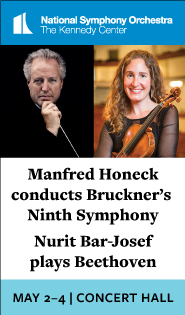Amid worries, Taiwan Philharmonic makes strong showing in historic D.C. visit

Jun Märkl conducted the Taiwan Philharmonic Orchestra Wednesday night at the Kennedy Center.
The Taiwan Philharmonic timed its first visit to Washington aptly. The group, which opened its U.S. tour last week with a chamber concert in New York, performed in full force Wednesday night at the Kennedy Center Concert Hall at a time of increased concerns about a potential invasion of the small island republic by China. The sea-centered program, presented by Washington Performing Arts, struck a note of international cultural diplomacy from the only part of historical China to remain a free democracy.
The main goal, co-sponsored by the Taipei Economic and Cultural Representative Office (TECRO), was to place a spotlight on the nation’s musical treasures. Music director Jun Märkl, familiar to local audiences for his guest appearances with the Baltimore Symphony Orchestra, opened the evening with the world premiere of Ebbs and Flows, a new work by Ke-Chia Chen. Born in Taiwan, she has lived in America for two decades and serves on the faculty at the Curtis Institute of Music in Philadelphia.
Chen has described the piece as “casting the orchestra as a massive body of water, like the ocean.” Drumbeats established a sense of tension at outset, as upward sprays of motion in the violins accompanied a forceful ostinato cello motif. Echoes of Stravinksy, specifically The Firebird, appeared at times, particularly when the piece surged into a maelstrom of sound. Evoking its title, the piece grew and receded in volume in several phases.
Märkl negotiated the tempo acceleration in the work’s final section with clear, insistent gestures, as tidal forces strengthened and abated. The opening section of music returned, to make a cohesive ending for the piece, but the overall effect of the work was underwhelming, in spite of some potent marshaling of the brass forces at the climaxes.
The Taiwanese-born violinist Paul Huang reportedly served as catalyst for the orchestra’s appearance with Washington Performing Arts. He took center stage as the soloist in Max Bruch’s Scottish Fantasy, the first half of a Scottish diptych with Mendelssohn’s Hebrides Overture, in store after intermission.

Paul Huang performed Bruch’s Scottish Fantasy Wednesday night. Photo: Marco Borggreve
The orchestra’s brass and percussion gave the slow opening march section a somber cast, followed by the slender, sweet tone from Huang’s violin on the first of many Scottish folk melodies quoted by Bruch. In the faster section in double-stops, Huang displayed both intensity and accuracy, culminating in some serene high E string playing at the end of the first movement.
Märkl kept the orchestra in step with Huang through the sprinting Scherzo, allowing perhaps too much ensemble volume at times for Huang’s sometimes reserved sound. The spirited variation with the violin’s decoration interwoven with the flute proved a high point. Orchestra and soloist both made their best sound together in the slow movement, with the wistful folk song “I’m A’ Doun for Lack O’ Johnnie” embroidered with figuration from harpist Shuen Chieh, given pride of place near the podium.
Huang’s superlative technique sparked the Finale with an edge of excitement. The folk song featured prominently in this last movement is the patriotic anthem “Scots Wha Hae.” Once considered the unofficial national anthem of Scotland, its words by Robert Burns evoke the bravery of the Scottish warriors at the Battle of Bannockburn. The words, unsung but with obvious resonance in this concert’s context, conclude with the last stanza: “Lay the proud usurpers low, / Tyrants fall in every foe, / Liberty’s in every blow!— / Let us do or die.” Coaxed into an encore, Huang played Kreisler’s Scherzo-Caprice, Op. 6, with consummate panache.
The program’s oceanic theme came full circle in the second half. Märkl, who conducted the entire program from memory, brought out maximal intensity from Mendelssohn’s Hebrides Overture. The stormy middle section featured violent waves of sound, with prominent brass and rolls of timpani. A very slow tempo choice as the piece calmed coincided with a rare technical shortcoming from this fine ensemble, a near-squawk from the clarinet.
For better or worse, Märkl gave the same insistent quality to Debussy’s La Mer, the musical seascape par excellence. Fine solo work came from the woodwinds and violin, as well as ardent playing from the divided cellos. The swell of brass and percussion in the final section crested majestically. Märkl’s approach tended to draw attention to individual colors, all striking, in the second movement, but sometimes sacrificed the sense of the longer ideas at play. At the same time, Märkl’s pointed interpretation gave the third movement a visceral thrill, with big climaxes and generally exciting tempi. Menacing half-step motifs ran through the piece.
In a parting gesture of hope and solidarity, the orchestra offered as an encore Tyzen Hsiao’s orchestral song “The Angel from Formosa,” which stylistically recalled Bruch’s use of Scottish folk song in his Scottish Fantasy.
Washington Performing Arts presents the Helsinki Philharmonic Orchestra, conductor Susanna Mälkki, and flutist Claire Chase in an all-Finnish program of music by Sibelius and Saariaho 8 p.m. May 8. washingtonperformingarts.org






